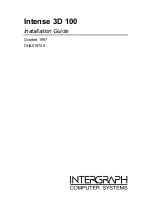
12
Chapter 2
Documentation Number 3PCIOSD2x-3903 Manual
B&B Electronics Mfg Co – 707 Dayton Rd - PO Box 1040 - Ottawa IL 61350 - Ph 815-433-5100 - Fax 815-433-5104
B&B Electronics Ltd – Westlink Comm. Pk. – Oranmore, Galway, Ireland – Ph +353 91-792444 – Fax +353 91-792445
RS-422 and RS-485 Termination
A 120 termination resistor has been provided for the RS-
422/485 receivers. Note that termination should only be used in
systems with both high baud rates (>19200) and over several
thousand feet of cable. If a value other than 120 is desired, space
for a through-hole resistor has been provided on the board over the
top of the surface mount termination resistor. These through-hole
termination resistors are labeled as RTAB for Port 1 and RTBB for
Port 2, both by its respective connector.
See our
RS-422/485
Application Note
for more discussion on termination
(available on
our websites).
RS-485 Network Biasing
Biasing is required on an RS-485 network to hold the network in the
marking state between transmissions. The 3PCIOSD2x RS-485
receiver is biased with a 4.7 K pull-up surface mount resistor on
the Receive Data B line and a 4.7 K pull-down surface mount
resistor on the Receive Data A line. These values are usually
adequate for networks without termination and small numbers of
nodes. For more complex networks, the user must calculate the
required value and replace these resistors. Space for through-hole
resistors has been provided over the top of the surface mount
components placed at the factory. The through-hole resistor for the
pull-up is marked as R5B and the pull-down is marked as R13B for
Port 1. Similarly, the pull-up is marked as R30B and the pull-down is
marked as R36B for Port 2.
4X Baud Rate Option
Baud rates higher than 115,200 are possible with the 3PCIOSD2x
card in RS-232, 422, or 485 mode. Jumper JP1 controls the clock
frequency (for both ports) supplied to the UARTs. By moving this
jumper to the “*4” (left) position, the clock frequency is increased
from 1.8432 to 7.3728 MHz. This multiplies all UART baud rates by
4 times. For example, if the software is set for 57.6K baud, the
actual baud rate will be increased by a factor of four to 230.4K baud.
In many systems, these higher baud rates can improve throughput
significantly. However, remember that baud rates and actual
throughput are only proportional if the system can keep up with the
communications, otherwise increasing the baud rate effectively only
increases the idle time between characters.
















































